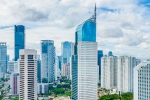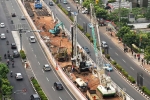Logistics performance: Lessons learned for Indonesia
This article has been translated by PwC Indonesia as part of our Indonesia Infrastructure News Service. PwC Indonesia has not checked the accuracy of, and accepts no responsibility for the content.
The Jakarta Post - Kinerja logistik: Pelajaran bagi Indonesia
18 August 2023
By: Ebi Junaidi
Jakarta - The World Bank's 2023 Logistics Performance Index (LPI) ranked Indonesia 63rd out of 139 countries. The country dropped 17 places from its 2018 ranking of 46, with a score of three (from a possible five) as against 3.15 five years ago.
The slump came as several Asian neighbors made progress, such as the Philippines, which rose 17 places (from 60 to 43), Malaysia which rose 11 places (from 41 to 30), India which jumped six spots (from 44 to 38), and Singapore which rose from seventh place to number one.
The questions are why has Indonesia's LPI declined, and what can we learn from those improving countries?
Lamia Bennis, a senior logistics specialist and a consultant from the World Bank, told a seminar held by Stranas PK on July 18 that the index should be considered the perception of logistics professionals in regard to Indonesia.
It is important to note that the LPI was sourced from a structured online survey of logistics professionals at multinational freight forwarders and the main global express carriers, such as DHL, FedEx, UPS, etc. In this case, the number of respondents for LPI 2023 totaled 652 globally, down by almost 25 percent from its 2018 survey, which involved 869 respondents.
Interestingly, Bennis created an analogy that the indicator may serve as a fever experienced by humans; it shows as a symptom, but the root cause might be different from one to another and therefore further analysis needs to be done.
To understand the LPI better, let us first detail the methodology of the LPI. Every respondent is asked to answer six core components of logistics performance questions in which five Likert-scale choices are provided. They need to fill out eight countries based on the trading partners of the respondents' selected country of work.
To allow for the coverage of all 139 countries, some random selection is also applied after 200 initial surveys. A total of 4,090 observations or country assessments from 115 countries, or an average of 30 observations for each country.
Having the above structure, the possibility of indirect comparison among the countries provides the average relative rank of the country with the seven other countries within its respective selected group, instead of an absolute measurement of a country's global performance.
If we analyze further, the category in Indonesia's LPI that experienced the decline in Indonesia's LPI performance from 2018 to 2023 was tracking and tracing (3.67 to 3.0) with a decrease in Indonesia's international ranking from 41 to 65. The development of infrastructure for tracking and tracing purposes is vital for this indicator.
Judging from the LPI infrastructure indicator, Singapore and India are superior to Indonesia mainly due to the significant development of infrastructure intended for logistics activities. PSA (2022) listed Singapore as the port with the best infrastructure connectivity with 600 ports in 120 countries.
Singapore's Ministry of Transportation (2022) also noted that Changi Airport's cargo aircraft are connected to 42 major destination countries. In terms of information technology, the Communication and Media Authority (2020) has implemented the Logistics Industry Digital Plan (LIDP) since 2016, in which the Internet of Things (IoT) is used as an integration of business supply chain digitalization and documents from upstream to downstream and incorporated in the national trade portal.
In terms of timeliness, a decrease in Indonesia's score from 3.67 to 3.3 has lowered its international ranking from 39 to 59. One of the important factors in timeliness is clearance time.
In the LPI, our LPI was much slower than that in many countries due to the high number of physical examinations. Indonesia's clearance time was seven days with a physical inspection rate of 8 percent.
Singapore and Malaysia, by contrast, recorded a clearance time of one day with a physical inspection rate of 2 percent, while Switzerland recorded a clearance time of one day with an inspection rate of 3 percent. India and the Philippines each have a clearance time of two days despite physically inspecting 19 and 30 percent, respectively, of goods.
India uses automated X-ray technology and the digitization of documents and customs payments within the India Custom National Trade Portal (ICEGATE) for the inspection of goods and the Philippines uses its Custom Modernization Program (PCMP).
In principle, Indonesia also applies X-ray technology for goods inspection and digitization of documents and payments through the Indonesia National Single Windows (INSW), but not in an optimum way so that the average clearance time stood at six to seven days.
Indonesia's logistics competence and quality of logistics service indicator also decreased in score from 3.1 to 2.9 with the international ranking also decreasing from 44 to 65. The Philippines and Malaysia seem to have succeeded in surpassing Indonesia because of their seriousness in providing extensive logistics education and training for various logistics actors.
The Philippines' Ministry of Manpower (2019) determined 21 types of logistics jobs with 80 percent of needs, thus providing various training and certifications so that in 2021 the logistics labor market was sufficient. Most of these types of jobs include drivers, supervisors, mechanics, route planners, mechanics and business developers.
For the record, the World Bank in 2018 explained that logistics competence and quality indicators include logistics actors in maritime transportation, aircraft and railways, as well as land transportation and warehousing routes. Agents of shipping companies, customs and excise officers, logistics associations, as well as freight forwarders are also included in the World Bank's assessment.
It is interesting to examine the reform initiated by Switzerland, whose customs indicator improved slightly from 2.67 to 2.8. Switzerland improved the most in the recent LPI as a result of the digitization of the customs system that has been pioneered in the DaziT program since 2018.
The program has been attended by 30,000 business partners from the private sector and the Ministry of Justice, and contains data integration of 33 million custom datasets, including goods codes and customs tariffs.
Customs applications from smartphones and automation systems at customs gates are also key to the success of this program. Freight forwarders can declare goods to customs online. Furthermore, Switzerland has installed 64 automatic sensor camera location points that can detect whether passing trucks have risky goods that need to be physically checked or can pass directly. This is in line with the 2018 World Bank LPI report, which revealed physical inspection of customs goods greatly slows down clearance time.
Those countries' efforts are proven to have paid off, so will Indonesia's.



















